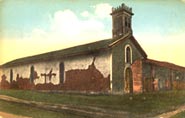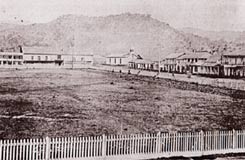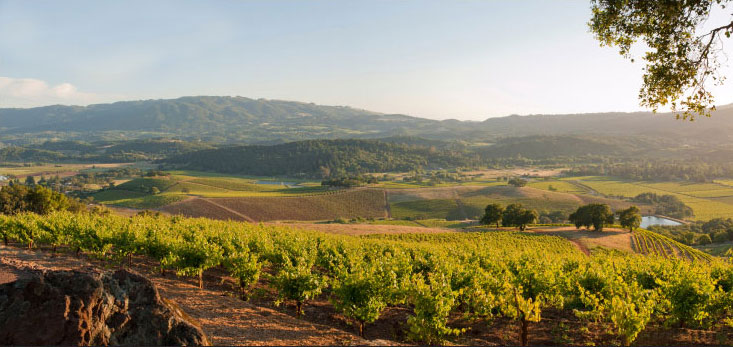History of Sonoma Plaza
 In 1823, Padre Jose Altimira of Spain established The Mission San Francisco Solano de Sonoma (Sonoma Mission) on land situated at the northeast corner of today’s Plaza. Sonoma Mission was the northern most Mission on the Camino Real, and was established to deter Russian incursions from the north.
In 1823, Padre Jose Altimira of Spain established The Mission San Francisco Solano de Sonoma (Sonoma Mission) on land situated at the northeast corner of today’s Plaza. Sonoma Mission was the northern most Mission on the Camino Real, and was established to deter Russian incursions from the north.
 In 1836, Mexico’s territorial governor for the area, General Mariano Guadelupe Vallejo, laid-out The Plaza’s eight acres and the surrounding street grid, turning Sonoma from a mission outpost to a Mexican style pueblo. He built the Barracks for Mexican army troops across the street from the Sonoma Mission, and he built his family’s first Sonoma home, La Casa Grande, on the west side. For a short time, Sonoma Plaza was the center of trade north of San Francisco.
In 1836, Mexico’s territorial governor for the area, General Mariano Guadelupe Vallejo, laid-out The Plaza’s eight acres and the surrounding street grid, turning Sonoma from a mission outpost to a Mexican style pueblo. He built the Barracks for Mexican army troops across the street from the Sonoma Mission, and he built his family’s first Sonoma home, La Casa Grande, on the west side. For a short time, Sonoma Plaza was the center of trade north of San Francisco.
 In 1908, Sonoma’s City Hall was built in the center of the Plaza – it was designed with four identical facades so that merchants from any side of the square could say the City Hall faced their businesses. Made of basalt stone from local quarries, the City of Sonoma government offices still remain in this central landmark of the valley.
In 1908, Sonoma’s City Hall was built in the center of the Plaza – it was designed with four identical facades so that merchants from any side of the square could say the City Hall faced their businesses. Made of basalt stone from local quarries, the City of Sonoma government offices still remain in this central landmark of the valley.
 In 1823, Padre Jose Altimira of Spain established The Mission San Francisco Solano de Sonoma (Sonoma Mission) on land situated at the northeast corner of today’s Plaza. Sonoma Mission was the northern most Mission on the Camino Real, and was established to deter Russian incursions from the north.
In 1823, Padre Jose Altimira of Spain established The Mission San Francisco Solano de Sonoma (Sonoma Mission) on land situated at the northeast corner of today’s Plaza. Sonoma Mission was the northern most Mission on the Camino Real, and was established to deter Russian incursions from the north.
 In 1836, Mexico’s territorial governor for the area, General Mariano Guadelupe Vallejo, laid-out The Plaza’s eight acres and the surrounding street grid, turning Sonoma from a mission outpost to a Mexican style pueblo. He built the Barracks for Mexican army troops across the street from the Sonoma Mission, and he built his family’s first Sonoma home, La Casa Grande, on the west side. For a short time, Sonoma Plaza was the center of trade north of San Francisco.
In 1836, Mexico’s territorial governor for the area, General Mariano Guadelupe Vallejo, laid-out The Plaza’s eight acres and the surrounding street grid, turning Sonoma from a mission outpost to a Mexican style pueblo. He built the Barracks for Mexican army troops across the street from the Sonoma Mission, and he built his family’s first Sonoma home, La Casa Grande, on the west side. For a short time, Sonoma Plaza was the center of trade north of San Francisco.
 In 1908, Sonoma’s City Hall was built in the center of the Plaza – it was designed with four identical facades so that merchants from any side of the square could say the City Hall faced their businesses. Made of basalt stone from local quarries, the City of Sonoma government offices still remain in this central landmark of the valley.
In 1908, Sonoma’s City Hall was built in the center of the Plaza – it was designed with four identical facades so that merchants from any side of the square could say the City Hall faced their businesses. Made of basalt stone from local quarries, the City of Sonoma government offices still remain in this central landmark of the valley.

